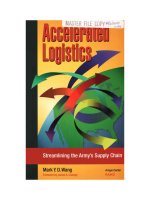The Logistics of Supply Chain Management docx
Bạn đang xem bản rút gọn của tài liệu. Xem và tải ngay bản đầy đủ của tài liệu tại đây (6.04 MB, 369 trang )
SUPPLY CHAIN
STRATEGY
The Logistics of Supply
Chain Management
Edward Frazelle
McGraw-Hill
New York Chicago San Francisco Lisbon London
Madrid Mexico City Milan New Delhi San Juan
Seoul Singapore Sydney Toronto
Copyright © 2002 by The McGraw-Hill Companies, Inc. All rights reserved. Manufactured in the United States of
America. Except as permitted under the United States Copyright Act of 1976, no part of this publication may be repro-
duced or distributed in any form or by any means, or stored in a database or retrieval system, without the prior writ-
ten permission of the publisher.
0-07-141817-2
The material in this eBook also appears in the print version of this title: 0-07-137599-6.
All trademarks are trademarks of their respective owners. Rather than put a trademark symbol after every occur-
rence of a trademarked name, we use names in an editorial fashion only, and to the benefit of the trademark owner,
with no intention of infringement of the trademark. Where such designations appear in this book, they have been
printed with initial caps.
McGraw-Hill eBooks are available at special quantity discounts to use as premiums and sales promotions, or for
use in corporate training programs. For more information, please contact George Hoare, Special Sales, at
or (212) 904-4069.
TERMS OF USE
This is a copyrighted work and The McGraw-Hill Companies, Inc. (“McGraw-Hill”) and its licensors reserve all
rights in and to the work. Use of this work is subject to these terms. Except as permitted under the Copyright Act
of 1976 and the right to store and retrieve one copy of the work, you may not decompile, disassemble, reverse engi-
neer, reproduce, modify, create derivative works based upon, transmit, distribute, disseminate, sell, publish or sub-
license the work or any part of it without McGraw-Hill’s prior consent. You may use the work for your own non-
commercial and personal use; any other use of the work is strictly prohibited. Your right to use the work may be
terminated if you fail to comply with these terms.
THE WORK IS PROVIDED “AS IS”. McGRAW-HILL AND ITS LICENSORS MAKE NO GUARANTEES OR
WARRANTIES AS TO THE ACCURACY, ADEQUACY OR COMPLETENESS OF OR RESULTS TO BE
OBTAINED FROM USING THE WORK, INCLUDING ANY INFORMATION THAT CAN BE ACCESSED
THROUGH THE WORK VIA HYPERLINK OR OTHERWISE, AND EXPRESSLY DISCLAIM ANY WAR-
RANTY, EXPRESS OR IMPLIED, INCLUDING BUT NOT LIMITED TO IMPLIED WARRANTIES OF MER-
CHANTABILITY OR FITNESS FOR A PARTICULAR PURPOSE. McGraw-Hill and its licensors do not warrant
or guarantee that the functions contained in the work will meet your requirements or that its operation will be unin-
terrupted or error free. Neither McGraw-Hill nor its licensors shall be liable to you or anyone else for any inaccu-
racy, error or omission, regardless of cause, in the work or for any damages resulting therefrom. McGraw-Hill has
no responsibility for the content of any information accessed through the work. Under no circumstances shall
McGraw-Hill and/or its licensors be liable for any indirect, incidental, special, punitive, consequential or similar
damages that result from the use of or inability to use the work, even if any of them has been advised of the possi-
bility of such damages. This limitation of liability shall apply to any claim or cause whatsoever whether such claim
or cause arises in contract, tort or otherwise.
DOI: 10.1036/0071418172
This book is dedicated to Jesus Christ
—
my Lord, Savior, and best friend;
Pat
—
the most noble and beautiful wife a husband could ever be blessed with;
and Kelly and Andrew
—
the most encouraging children a father could ever know.
This page intentionally left blank.
ix
S
UPPLY
C
HAIN
S
TRATEGY
: The Logistics of Supply Chain Manage-
ment teaches the best practices and basics in logistics and supply
chain management. The book is richly illustrated with 238 fig-
ures featuring logistics principles in action at the world’s best
logistics organizations. In a conversational style, the book presents
best-practice, common-sense, high-tech, high-touch, and analytical solutions
for logistics challenges spanning the entire supply chain. From customer ser-
vice to inventory planning to supply to transportation to warehousing, Supply
Chain Strategy puts the logic back in logistics!
The book is organized according to Dr. Edward Frazelle’s Logistics
Master Planning methodology for developing supply chain strategy. Three
major sections address the investigation, innovation, and implementation of
logistics solutions to supply chain problems. In so doing, the book presents
simultaneously a methodology for planning and managing logistics activi-
ties while illustrating world-class practices and systems in use by logistics
organizations around the globe. In addition, each chapter stands alone in
addressing the major issues in logistics data mining, logistics performance
measurement, customer response, inventory planning and management,
supply management, transportation, warehousing, logistics information sys-
tems, and logistics organization design and development.
Preface
Copyright 2002 by The McGraw-Hill Companies, Inc. Click here for Terms of use.
Preface ix
Acknowledgments x
Chapter 1 The Definition, Evolution, and Role of Logistics in
Business 1
1.1 The Definition of Logistics 5
1.2 The Evolution of Logistics and Supply
Chain Management 5
1.3 Logistics Activities 12
1.4 Logistics Optimization 15
1.5 Logistics Master Planning 17
1.6 Logistics Around the World: Necessity Is the
Mother of Invention 21
Section I Investigating Logistics Performance
and Practices 23
Chapter 2 Logistics Activity Profiling and Data Mining 24
2.1 Profiling Motivations and Minefields 26
2.2 Logistics Activity Profiles 27
2.3 Logistics Data Mining 31
Chapter 3 Logistics Performance, Cost, and Value Measures 38
3.1 Financial Measures of Logistics Performance 40
3.2 Productivity Measures of Logistics Performance 48
3.3 Quality Measures of Logistics Performance 54
Contents
v
For more information about this book, click here.
Copyright 2002 by The McGraw-Hill Companies, Inc. Click here for Terms of use.
3.4 Cycle Time Measures of Logistics Performance 62
3.5 Logistics Performance Gap Analysis 63
Section II Innovating Logistics Practices and Systems 69
Chapter 4 Customer Response Principles and Systems 70
4.1 Customer Response Fundamentals and Notations 71
4.2 Customer Activity Profiling 73
4.3 Customer Response Performance Measures 76
4.4 Customer Service Policy Design 78
4.5 Customer Satisfaction Monitoring 82
4.6 Order Capture and Entry 83
4.7 Order Processing 84
4.8 Documentation, Invoicing, and Collections 88
4.9 Customer Response Systems 88
4.10 Customer Response Organization Design
and Development 89
Chapter 5 Inventory Planning and Management 91
5.1 Inventory Fundamentals 96
5.2 Inventory Activity Profiling 106
5.3 Inventory Performance Measurement 109
5.4 Forecasting 113
5.5 Order Quantity Engineering 121
5.6 Fill Rate Planning 124
5.7 Inventory Control Policy and Replenishment Design 127
5.8 Inventory Deployment 137
5.9 Inventory Management Systems 142
5.10 Inventory Organization Design and Development 143
Chapter 6 Supply Management 145
6.1 Fundamentals of Supply 146
6.2 Supply Activity Profiling 146
6.3 Supply Performance Measurement 149
6.4 Supplier Service Policy (SSP) 152
6.5 Sourcing 155
6.6 Supplier Integration and Relationship Management 159
6.7 Purchase Order Processing 164
6.8 Buying and Payment 166
vi
CONTENTS
6.9 Supply Management Systems 167
6.10 Supply Organization Design and Development 168
Chapter 7 Transportation and Distribution Management 169
7.1 Transportation Optimization 171
7.2 Transportation Fundamentals 174
7.3 Transportation Activity Profiling and Data Mining 175
7.4 Transportation Performance Measures 180
7.5 Logistics Network Design 188
7.6 Shipment Planning and Management 195
7.7 Fleet, Container, and Yard Management 209
7.8 Carrier Management 217
7.9 Freight and Document Management 218
7.10 Transportation Management Systems (TMSs) 220
7.11 Transportation Organization Design
and Development 221
Chapter 8 Warehouse Operations 224
8.1 Warehousing Fundamentals 225
8.2 Warehouse Activity Profiling 231
8.3 Warehouse Performance Measures 241
8.4 Receiving Principles 243
8.5 Putaway 248
8.6 Storage Operations 252
8.7 Order Picking Operations 259
8.8 Shipping Principles 267
8.9 Warehouse Management Systems 270
8.10 Warehouse Workforce Design and Development 272
Section III Implementing Logistics Systems 275
Chapter 9 Logistics and Supply Chain Information Systems 276
9.1 Logistics Information System (LIS) Functionality
and Architectures 278
9.2 Logistics Data Warehousing, Data Mining
and Decision Support Systems 282
9.3 Web-Based Logistics 287
9.4 Paperless and Wireless Logistics Systems 295
9.5 LIS Justification, Selection, and Implementation 308
CONTENTS vii
Chapter 10 Logistics Organization Design and Development 311
10.1 Supply Chain Organization Management 312
10.2 Corporate Logistics Organization Alignment 319
10.3 Logistics Strategic Planning and Project Management 328
10.4 Logistics Process and Activity Management 333
10.5 Logistics Professional Development 343
10.6 Human-Friendly Logistics 343
10.7 Community-Friendly Logistics 345
Acronyms and Abbreviations 347
Index 353
viii
CONTENTS
I
N THE LAST TEN YEARS
, God has led me through a series of consulting
and research projects literally spanning the globe to work with the
world’s best logistics organizations in all areas of logistics manage-
ment. During that time, He taught me a framework for logistics man-
agement and problem solving that is the essence of this book. He also
showed me examples of the world’s best logistics practices. Those illustra-
tions are sprinkled throughout the book.
I have been blessed with a career overflowing with support and encour-
agement from family, mentors, business partners, staff, consulting clients,
and students of all ages. Because this book is a summary of my consulting
and research in logistics, all those kind folks have contributed to this book.
It would take another book just to name all the individuals involved in the
projects covered in this book. I don’t have time or space to name each indi-
vidual, but I do want to say a special thanks to several individuals and orga-
nizations who have made significant contributions.
Even though my mother was an English teacher, I still need an inordi-
nate amount of support with editing. Ms. Freida Breazeal with The Logistics
Institute at Georgia Tech, Tammy Artosky with Logistics Resources
International, and Steve Erbe with Walt Disney World assisted me with
reviewing and editing the manuscript.
This book could not come to life if it were not for a variety of organi-
zations willing to allow me to share lessons learned during my work with
them. My most sincere appreciation goes out to Hal Welsh, Lynn Barratt,
Steve Erbe, Tom Nabbe, Bruce Terry, and Karen Hall with Walt Disney
World Distribution Services; Carliss Graham with BP; Tony Fuller and
Matthew Anderson with the U.S. Armed Services Velocity Management
Program; Mike Graska with Swagelok; Jack Gross with Applied Materials;
Roosevelt Tolliver with Avon Products; Bill Hightower with BellSouth; Joe
Neal and Jerel Williams with Payless ShoeSource; Will Walker with NOR-
TEL; Mike Harry with Lifeway Christian Resources; Brad Morris with
NuSkin International; Bob Hribernik with Techdata; and Raul Mendez with
Coca-Cola.
This book could also not come to life if it were not for my partners in
logistics consulting who encourage and teach me daily and keep me involved
on the frontlines of logistics problem solving. Thanks to Hugh Kinney, Hugh
Kinney Jr., Juan Rubio, Ricardo Sojo, Ron Gable, and Masaji Nakano.
x
Acknowledgments
Copyright 2002 by The McGraw-Hill Companies, Inc. Click here for Terms of use.
THE DEFINITION,
EVOLUTION, AND ROLE OF
LOGISTICS IN BUSINESS
“But many who are first will be last, and many who are last will
be first.”
Matthew 19:30
A
FTER WINNING BACK
-
TO
-
BACK
World Series titles, Sparky
Anderson, then manager of the Cincinnati Reds, was asked
what it felt like to be on top of the world. His simple reply was,
“Every dog has his day.” As logistics professionals, once the
lowest professionals on the corporate totem pole, we are hav-
ing our day.
During this past year, logistics has been featured on the cover of the Wall
Street Journal, Forbes, Fortune, and Business Week magazines. It is no
wonder.
• Logistics expenditures represent about 10 percent of the U.S. gross
domestic product and are approximately $1 trillion annually (see
Figure 1-1).
• Global logistics expenditures exceed $3.5 trillion annually and
represent nearly 20 percent of the sum total of the world’s GDP (see
Figure 1-2).
1
1
CHAPTER
Copyright 2002 by The McGraw-Hill Companies, Inc. Click here for Terms of use.
2 SUPPLY CHAIN STRATEGY
FIGURE 1-1 U.S. logistics expenditure 1989–1999.
Source: Cass Logistics
1989
1990
1991
1992
1993
1994
1995
1996
1997
1998
1999
2.0%
3.0%
4.0%
5.0%
6.0%
7.0%
8.0%
9.0%
10.0%
11.0%
12.0%
Total Logistics Cost/GDP
Inventory Carrying Cost/GDP
Transportation Cost/GDP
FIGURE 1-2 Global logistics expenditures.
Source: Michigan State University
$Billions in USD
1996
1992
All Other (12.9%)
Asia/Pacific (11.6%)
Europe (11.8%)
North America
(10.8%)
$– $200 $400 $600 $800 $1,000
$837
$915
$877
$941
$916
$662
$516
$652
• Most U.S. corporations spend between 8 percent and 15 percent of
sales revenue on logistics activities (see Figure 1-3).
Logistics is being recognized as perhaps the last frontier for major cor-
porations to significantly increase shareholder and customer value. An
excellent example is the Coca-Cola corporation. With the world’s most rec-
ognized brand, Coke is the envy of the world in marketing. With a route dri-
ver or order taker appearing in nearly every customer location, nearly every
day, Coke’s customer service is outstanding. With a product made for over
a century by the same mixing of sugar, water, carbonation, and flavoring,
theoretical capacities for production quality and efficiency are being reached.
The linking of those world-class marketing, customer service, and produc-
tion processes, logistics, is the next great frontier for Coca-Cola and many
other enterprises.
Logistics and its younger cousin, supply chain management, are popu-
lar but greatly misunderstood topics. Logistics and supply chain manage-
ment are new concepts in private industry. A minority of the professionals
who work in logistics have formal training in logistics. Logistics and sup-
ply chain management cut across and draw from personnel in a multiplic-
ity of disciplines. It is no wonder that confusion abounds and that a majority
of logistics projects never reach their intended goals or wind up as cata-
strophic failures. Add to this a marketplace that includes more than one thou-
sand vendors of logistics software, three thousand transportation providers,
and one thousand providers of third-party logistics, and we have a situation
ripe for unmet promises and potential. The unmet potential is evidenced by
the fact that less than 30 percent of all logistics projects ever achieve their
intended goals (if the project involves software, the success rate drops to less
than 15 percent) and that logistics productivity in the United States in the
last few years has remained flat. We believe (and our benchmarking supports)
that the underlying cause of recent failures in logistics is that the tools, tech-
nology, and training available to logistics professionals are not keeping pace
with growing logistics complexities. In short and ironically, there is not
nearly enough logic in logistics!
CHAPTER 1 THE DEFINITION, EVOLUTION, AND ROLE OF LOGISTICS IN BUSINESS 3
FIGURE 1-3 Logistics expenditures versus sales for various industries.
Source: Herb Davis & Associates
0.00%
2.00%
4.00%
6.00%
8.00%
10.00%
12.00%
14.00%
M
ANUFACTURING
Industrial
Consum
er G
oods
Food & Beverage
G
eneral M
erchandise
Pharm
aceuticals
G
rocery
W
HO
LESALERS
RETAILER
S
$100.00
$90.00
$80.00
$70.00
$60.00
$50.00
$40.00
$30.00
$20.00
$10.00
$–
Logistics Cost to Sales Ratio
Logistics Cost per Hundred Weight
$33.36
$39.39
$31.38
$8.22
$38.22
$15.19
$86.00
4.31%
7.99%
8.49%
7.44%
7.82%
7.60%
7.77%
5.34%
11.68%
$44.11
$86.15
This observation is based on my work with Fortune 1000 clients in a
wide variety of industries and by statements made to me by many of the par-
ticipants in our professional education programs. This observation motivated
me in 1992 to organize The Logistics Institute at Georgia Tech, to develop
the Logistics Management Series of courses, to form Logistics Resources
International, and to author this book
—
each endeavor with the common
motivation to teach and illustrate the following:
•A definition of logistics (Chapter 1, “The Definition, Evolution and
Role of Logistics in Business”)
•A methodology for logistics problem solving (Chapter 1)
•A profile of logistics activity (Chapter 2, “Logistics Activity Profiling
and Data Mining”)
•A scoreboard of logistics performance measures (Chapter 3,
“Logistics Performance, Cost, and Value Measures”)
•A standard for world-class logistics practices in customer response
(Chapter 4, “Customer Response Principles and Systems”), inventory
management (Chapter 5, “Inventory Planning and Management”),
supply (Chapter 6, “Supply Management”), transportation (Chapter 7,
“Transportation and Distribution Management”), and warehousing
(Chapter 8, “Warehousing and Fulfillment Operations”)
•An architecture for logistics and supply chain management systems
(Chapter 9, “Logistics and Supply Chain Management Systems”)
•A development program for logistics organizations (Chapter 10,
“Logistics Organization Design and Development”)
that consistently yields higher levels of customer service, higher corporate
valuations, and lower logistics costs. That definition, along with methodol-
ogy, scoreboard, standard, architecture, and development program we call
The Logistics of Supply Chain Management.
The story begins here with the definition, evolution, and role of logis-
tics in business. This chapter presents
•A formal definition of logistics and supply chain management (Section
1.1, “The Definition of Logistics”)
• The evolution of logistics and supply chain management (Section 1.2,
“The Evolution of Logistics and Supply Chain Management”)
• Descriptions of the five interdependent logistics activities (Section
1.3, “Logistics Activities”)
• Logistics optimization (Section 1.4, “Logistics Optimization”)
4 SUPPLY CHAIN STRATEGY
• Logistics master planning (LMP) methodology (Section 1.5,
“Logistics Master Planning”)
• Logistics conditions around the world (Section 1.6, “Logistics Around
the World”)
1.1 THE DEFINITION OF LOGISTICS
I was recently asked by a large food manufacturer to help them develop a
formal logistics organization. At the kickoff meeting, the participants spent
the first 2 hours arguing with one another about who should be represented
in the new organization. As utter frustration was setting in and the first meet-
ing was about to adjourn by default, it finally dawned on me why we were
not able to make any progress. Each person in the room came to logistics
without a formal degree in logistics and from a different professional disci-
pline. One came from marketing, another from sales, another from mater-
ial management, another from manufacturing, another from warehousing,
another from transportation, and another was the nephew of the chairman
of the board. As a result, each had his or her own different definition of logis-
tics. It is impossible to develop anything, let alone an organization, for a
process that is not even defined, and where each of the major players speaks
a different language.
Remember what God did to humble the people who were trying to build
a monument to themselves reaching all the way to Heaven? He gave them
all a different language, so that the people could not communicate with each
other. As a result, they could not complete the construction of the tower. We
are the same way in logistics; if we can’t speak the same language, we can’t
start, let alone finish a project.
Our definition of logistics is simple. Logistics is the flow of material,
information, and money between consumers and suppliers. The confusion
in the definition enters when logistics is placed in context, when it is con-
fused with many of the buzzwords that incorporate logistics, when it is mixed
up with the objectives of logistics, and/or confused with the interdependent
processes that make up logistics. To help clear up some of the potential
confusion, we’re going to now review five different contexts for logistics that
also serve as a presentation of the evolution of logistics.
1.2 THE EVOLUTION OF LOGISTICS
AND SUPPLY CHAIN MANAGEMENT
Paralleling advances in management theory and information systems, logis-
tics has evolved in scope and influence in the private sector since the mid
CHAPTER 1 THE DEFINITION, EVOLUTION, AND ROLE OF LOGISTICS IN BUSINESS 5
to late 1940s. In the 1950s and ‘60s, the military was the only organization
using the term logistics. There was no true concept of logistics in private
industry at that time. Instead, departmental silos including material handling,
warehousing, machining, accounting, marketing, and so on, were the norm.
The five phases of logistics development
—
workplace logistics, facility
logistics, corporate logistics, supply chain logistics, and global logistics
—
are plotted in time in Figure 1-4.
Workplace Logistics
Workplace logistics (see Figure 1-5) is the flow of material at a single work-
station. The objective of workplace logistics is to streamline the movements
of an individual working at a machine or along an assembly line. The prin-
ciples and theory of workplace logistics were developed by the founders of
industrial engineering working in WWII and post-WWII factory operations.
A popular name today for workplace logistics is ergonomics.
Facility Logistics
Facility logistics (see Figure 1-6) is the flow of material between worksta-
tions within the four walls of a facility (that is, interworkstation and intra-
facility). The facility could be a factory, terminal, warehouse, or distribution
center. Facility logistics has been more commonly referred to as material
handling. The roots of facility logistics and material handling are in the mass
production and assembly lines that distinguished the 1950s and 1960s. In
those times and even into the late 1970s, many organizations maintained
material-handling departments. Today, the term material handling has fallen
out of favor because of its association with nonvalue added activities.
6 SUPPLY CHAIN STRATEGY
FIGURE 1-4 The evolution of logistics.
Workplace
Logistics
Workplace
Logistics
Facility
Logistics
Facility
Logistics
Corporate
Logistics
Corporate
Logistics
Supply
Chain
Logistics
Supply
Chain
Logistics
Global
Logistics
Global
Logistics
1950’s 1960’s 1970’s 1980’s 1990’s
Workplace
Logistics
Workplace
Logistics
Facility
Logistics
Facility
Logistics
Corporate
Logistics
Corporate
Logistics
Supply
Chain
Logistics
Supply
Chain
Logistics
Global
Logistics
Global
Logistics
Scope & Influence
In the 1960s, material handling, warehousing, and traffic were grouped
together to become known as physical distribution; procurement, marketing,
and customer service were grouped together to become known as business
logistics. (Even today in many academic institutions, logistics is still divided
CHAPTER 1 THE DEFINITION, EVOLUTION, AND ROLE OF LOGISTICS IN BUSINESS 7
FIGURE 1-5 Workplace logistics.
Source: Bertlesmann
FIGURE 1-6 Facility logistics.
Source: Lifeway Christian Resources
Packing
Order
Completion
Zone
A+ Movers
in Flow Rack
1
2
3
4
A’s
B’sC’s
Shipping
Stations
along these lines; where logistics is taught in the business school, it is taught
as business logistics, and in the engineering schools as physical distribution.)
Corporate Logistics
As management structures advanced and information systems accordingly,
our ability to assimilate and synthesize departments (material handling,
warehousing, and so on) into functions (physical distribution and business
logistics) in the 1970s permitted the first application of true logistics within
a corporation. Corporate logistics became a process with the common
objective to develop and maintain a profitable customer service policy while
maintaining and reducing total logistics costs.
Corporate logistics (see Figure 1-7) is the flow of material and infor-
mation between the facilities and processes of a corporation (inter-
workstation, inter-facility, and intra-corporate). For a manufacturer, logistics
activities occur between its factories and warehouses; for a wholesaler,
between its distribution centers; and for a retailer, between its distribution
centers and retail stores. Corporate logistics is sometimes associated with
the phrase physical distribution that was popular in the 1970s. In fact, the
Council of Logistics Management (CLM) was called the National Council
of Physical Distribution Management (NCPDM) until 1982.
Supply Chain Logistics
Supply chain logistics (see Figure 1-8) is the flow of material, information,
and money between corporations (interworkstation, interfacility, intercor-
porate, and intrachain).
There is a lot of confusion surrounding the terms logistics and supply
chain management. I distinguish the two by explaining that the supply chain
is the network of facilities (warehouses, factories, terminals, ports, stores,
and homes), vehicles (trucks, trains, planes, and ocean vessels), and logis-
tics information systems (LIS) connected by an enterprise’s supplier’s sup-
pliers and its customer’s customers. Logistics is what happens in the supply
chain. Logistics activities (customer response, inventory management, sup-
ply, transportation, and warehousing) connect and activate the objects in the
supply chain. To borrow a sports analogy, logistics is the game played in the
supply chain arena.
It is unfortunate that the phrase supply chain management has been so
readily and commonly adopted as a reference to excellence in logistics. First,
it is not supply (or demand) that should dictate the flow of material, infor-
mation, and money in a logistics network. Actually, there are some links in
the chain and some circumstances in which supply should dictate flow and
8 SUPPLY CHAIN STRATEGY
9
FIGURE 1-7
Corporate logistics flows.
DC
DC
DC
DC
DC
DC
DC
DC
DC
DC
DC
DC
DC
DC
DC
DC
DC
DC
DC
DC
DC
DC
DC
DC
DC
DC
DC
DC
DC
DC
DC
DC
DC
DC
Finished Goods
Bottles
Pre-Sell Orders
Empties
Route Requirements
Empties & Cases
Inventory Reqts.
Empties & Pallets
Purchase Orders
Cash
DC
Route 1
2 Sectors
Route 2 Route 3
Route 200
Finished Goods
Cases
Finished Goods
Pallets
Raw Materials
Delivery Transportation
Freight Transportation
Concentrate
Sugar
Water
Glass
Plastic
Empties
Plant II
4 Lines
Plant I
3 Lines
Plant III
5 Lines
Freight Transportation
Freight Transportation
Inbound Transportation
some in which demand should dictate flow. Second, if you drew lines con-
necting all the trading partners in a typical supply chain, what you would
see would not look anything like a chain. You would see something that looks
more like a complex web of links.
A chain stretched full is a line. The danger in the choice of the term chain
is that the term oversimplifies the complexities in logistics management and
leads to inflated expectations for what can be achieved by supply chain man-
agement systems. Finally, the term management suggests that a single party
in the chain can truly manage and dictate the operations of the supply chain.
Instead, the best any party can do is to collaboratively plan the operations
of the chain. Consider the computing industry supply chain with players like
HP, Microsoft, Intel, UPS, FEDEX, Sun, Ingram-Micro, Compaq,
CompUSA, and so on. There is not a single one of those parties who can or
should manage the entire computing industry supply chain.
Global Logistics
Global logistics (see Figure 1-9) is the flow of material, information, and
money between countries. Global logistics connects our suppliers’ suppli-
ers with our customers’ customers internationally. Global logistics flows have
increased dramatically during the last several years due to globalization in
the world economy, expanding use of trading blocs, and global access to Web
sites for buying and selling merchandise. Global logistics is much more com-
plex than domestic logistics, due to the multiplicity of handoffs, players, lan-
10 SUPPLY CHAIN STRATEGY
FIGURE 1-8 Supply chain logistics.
Supply Chain Flows
Manufacturer
Wholesaler
Retailer
Consumer
Supplier
Supplier to Consumer (SC)
Manufacturer to Consumer (MC)
Wholesaler to Consumer (WC)
Supplier to Wholesaler (SW)
Supplier to Retailer (SR)
Manufacturer to Retailer (SR)
MW
WR RC
SM
Supply chain flow is optimized when material, information,
and money flow simultaneously, in real time, and without paper.
guages, documents, currencies, time zones, and cultures that are inherent to
international business.
Next-Generation Logistics
There are many theories as to the next phase of logistics development. Many
logisticians believe that collaborative logistics, logistics models built with
continuous and real-time optimization and communication between all sup-
ply chain partners, will be the next phase of evolution. Other camps in the
logistics community believe the next phase of evolution will be virtual logis-
tics or fourth-party logistics, where all logistics activities and management
will be outsourced to third-party logistics providers who are in turn man-
aged by a master or fourth-party logistics providers acting kind of like a
general contractor. I used to joke that interplanetary logistics would be the
next phase of evolution until the director of logistics for NASA and the inter-
national space station program showed up in our Logistics Management
Series and began asking my advice on how to get parts to Mars to support
their next mission.
The only thing I can predict with confidence about the future of logis-
tics is that it will continue to play a major role in the success or failure of
most corporations, and that it will continue to expand in scope and influ-
ence as management theories and information systems continue to advance.
I can also predict with confidence that each stage of logistics development
is and will be a prerequisite to success in the other stages. Many organiza-
tions have left behind the proven disciplines and best practices learned in
CHAPTER 1 THE DEFINITION, EVOLUTION, AND ROLE OF LOGISTICS IN BUSINESS 11
FIGURE 1-9 Global logistics flows.
Asia-
Pacific
Central
America
NAFTA
European
Union
East Coast Port
of Exit is New
York City.
West Coast Port
of Exit is Long
Beach.
Amsterdam is
EU Distribution
Hub.
Tokyo is Asia-
Pacific Distribution
Hub.
the early stages of logistics development and are finding it difficult to suc-
ceed in the more advanced stages. I personally believe that poor execution
of the basics of logistics management is the fundamental reason for the busi-
ness failure of so many dotcoms and pure e-tailers, and that consistent exe-
cution of the basics of logistics management is the reason traditional
brick-and-mortar companies have withstood and flourished during the
e-wave. A wise prophet once said that when we are faithful with the small
things, we will be blessed with the larger things.
1.3 LOGISTICS ACTIVITIES
In our definition, logistics is comprised of five interdependent activities: cus-
tomer response, inventory planning and management, supply, transportation,
and warehousing. Each activity and its objective is described briefly in Figure
1-10 and in detail in Chapters 4 through 8.
Customer Response
Customer response links logistics externally to the customer base and inter-
nally to sales and marketing. Customer response is optimized when the cus-
tomer service policy (CSP) yielding the lowest cost of lost sales, inventory
carrying, and distribution is identified and executed.
12 SUPPLY CHAIN STRATEGY
FIGURE 1-10 Interdependent logistics activities.
W
AR
EH
O
U
SIN
G
CUSTOM
ER
RESPO
NSE
INVENTORY
MANAGEMENT
LOGISTICS
TRANSPO
RTATIO
N
SUPPLY
The logistics of customer response includes the activities of
• Developing and maintaining a customer service policy
• Monitoring customer satisfaction
• Order Entry (OE)
• Order Processing (OP)
• Invoicing and collections
Definitions, illustrations, measures, and world-class practices for each of
these customer response activities will be presented in Chapter 4.
Inventory Planning and Management
The objective of inventory planning and management (IP&M) is to deter-
mine and maintain the lowest inventory levels possible that will meet the cus-
tomer service policy requirements stipulated in the customer service policy.
The logistics of inventory planning and management includes
• Forecasting
• Order quantity engineering
• Service level optimization
• Replenishment planning
• Inventory deployment
Definitions, illustrations, measures, and world-class practices for each
of these inventory management activities will be presented in Chapter 5.
Supply
Supply is the process of building inventory (through manufacturing and/or
procurement) to the targets established in inventory planning. The objective
of supply management is to minimize the total acquisition cost (TAC) while
meeting the availability, response time, and quality requirements stipulated
in the customer service policy and the inventory master plan. The logistics
of supply include
• Developing and maintaining a Supplier Service Policy (SSP)
• Sourcing
• Supplier integration
• Purchase order processing
• Buying and payment
Definitions, illustrations, measures, and world-class practices for each
of these supply activities will be presented in Chapter 6.
CHAPTER 1 THE DEFINITION, EVOLUTION, AND ROLE OF LOGISTICS IN BUSINESS 13
Transportation
Transportation physically links the sources of supply chosen in sourcing with
the customers we have decided to serve chosen as a part of the customer service
policy. We reserve transportation for the fourth spot in the logistics activity
list because the deliver-to points and response time requirements determined
in the customer service policy and the pick-up points determined in the sup-
ply plan must be in place before a transportation scheme can be developed.
The objective of transportation is to link all pick-up and deliver-to points
within the response time requirements of the customer service policy and
the limitations of the transportation infrastructure at the lowest possible cost.
The logistics of transportation includes
• Network design and optimization
• Shipment management
• Fleet and container management
• Carrier management
• Freight management
Definitions, illustrations, measures, and world-class practices for each
of these transportation activities will be presented in Chapter 7.
Warehousing
I present warehousing as the last of the five logistics activities because good
planning in the other four activities may eliminate the need for warehous-
ing or may suggest the warehousing activity be outsourced. In addition, a
good warehouse plan incorporates the needs of all the other logistics activ-
ities. Good or bad, the warehouse ultimately portrays the efficiency or inef-
ficiency of the entire supply chain.
The objective of warehousing is to minimize the cost of labor, space,
and equipment in the warehouse while meeting the cycle time and shipping
accuracy requirements of the customer service policy and the storage capac-
ity requirements of the inventory play. The logistics of warehousing includes
• Receiving
• Putaway
• Storage
• Order picking
• Shipping
Definitions, illustrations, measures, and world-class practices for each
of these warehousing activities will be presented in Chapter 8.
14 SUPPLY CHAIN STRATEGY









